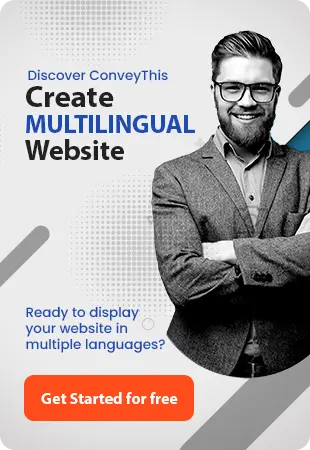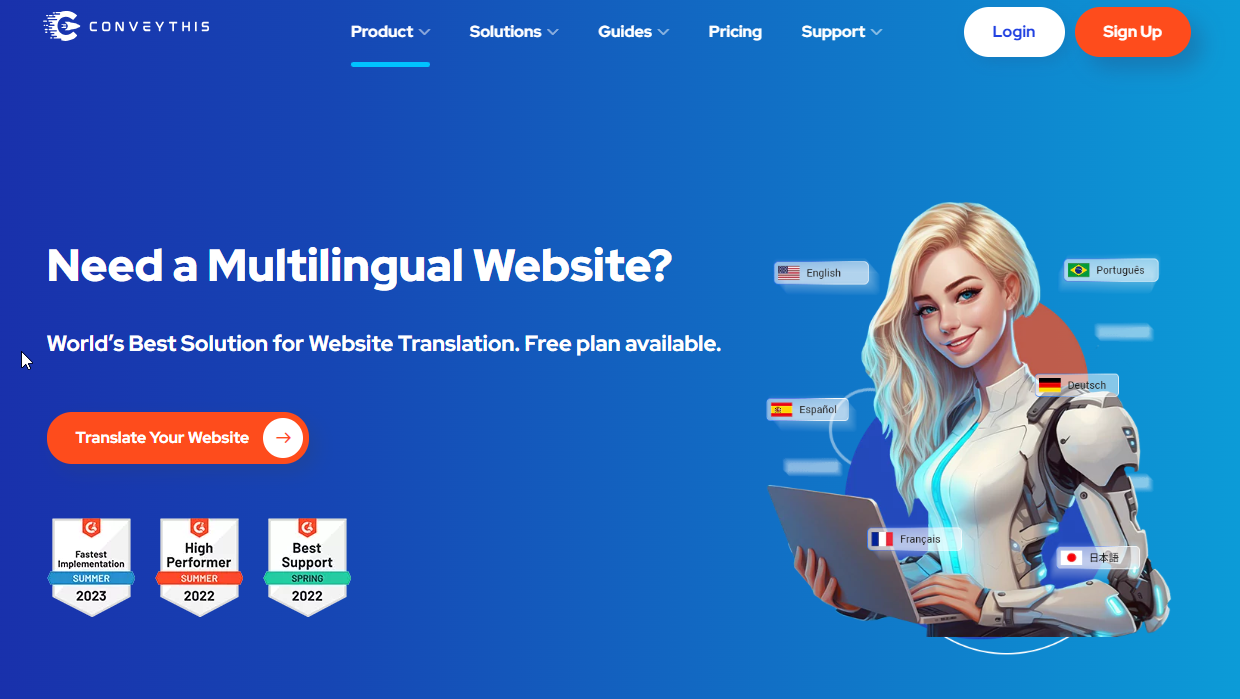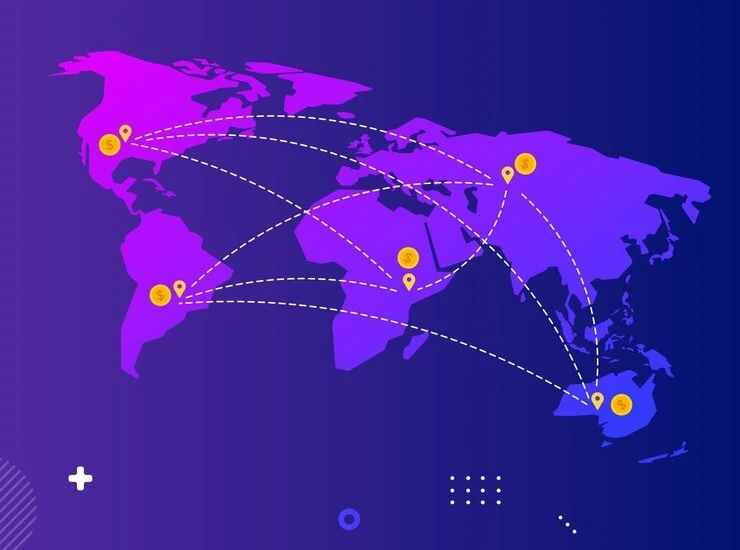How to Translate Your Widgets and Strengthen Your Multilingual Website: 5 Simple Ways
Having a fully bilingual or multilingual website with an enhanced user experience for visitors from all over the world is critical for broadening your reach and increasing business opportunities. The ability to translate all aspects of your website, including posts, pages, content, and widgets, is essential for creating a professional and cohesive experience.
While English dominates the internet, accounting for over half of all web content, only 25% of internet users speak English as their first language. This highlights the need for a multilingual website that caters to a global audience. Translating widgets is an integral part of this process, as it opens up significant opportunities to engage with a larger, more diverse audience, making your business more accessible and increasing your reach.
Widgets, as a key element of many multilingual websites, often go untranslated. If translation is not handled properly by your chosen translation plugin or tools, it’s common to find widgets remaining in the original language. This inconsistency can lead to a situation where some parts of the website are in one language, while others are in a different language. This leads to a poor user experience and a phenomenon known as language code-mixing.
This issue can make visitors feel disconnected or unwelcome, particularly if they see part of the website in their native language and part in another. A comprehensive solution for content translation, including all website elements, is necessary for a successful multilingual website.
In this article, we will guide you through the process of translating the widgets on your multilingual WordPress website. We will also explore how you can use widgets as your language switcher, replacing the typical switcher button. To demonstrate the process, we will use the best WordPress translation plugin—ConveyThis—as the tool for the training. While this article focuses on WordPress, it’s important to note that ConveyThis can be used on other platforms as well.
By following the steps in this article, you will achieve quick and effective results that contribute to the overall success of your multilingual website.
What are widgets and why is it necessary to get them translated?
Widgets are small, versatile components or blocks of content that perform specific functions on a website. They typically exist outside of the main content area of a page, appearing in sidebars, footers, headers, or other widget-ready areas. Widgets are an integral part of many multilingual websites, enabling site owners to enhance user interaction and functionality without adding complex custom code.
Examples of widgets include search bars, recent posts lists, social media buttons, navigation menus, calendars, image galleries, subscription forms, and more.
Key Types of Widgets:
- Navigation Widgets: These widgets help users navigate through the website, like menus, category lists, or tags.
- Search Widgets: Allow users to search the site by entering keywords.
- Social Media Widgets: Provide easy access to social media profiles or content sharing options.
- Forms: Contact forms, subscription forms, and feedback forms fall into this category.
- Content Display Widgets: These include recent blog posts, upcoming events, product carousels, etc.
- Custom Widgets: These could be unique elements added by the website administrator, such as banners or customized interactive elements.
Why is it Necessary to Translate Widgets?
The necessity of translating widgets arises from the growing global audience of websites and the increasing importance of localization in multilingual websites. A multilingual approach to web content allows businesses to serve visitors from different regions and cultures, creating an experience that resonates with users in their native languages.
While translating the primary website content (like articles, product descriptions, and service pages) is essential, translating widgets is equally important for several reasons:
- Consistency Across All Website Elements:
When users visit a multilingual website in their preferred language, they expect the entire website—every button, form, and label—to be in that language. If the core content is translated but the widgets are left in the default language (typically English), this creates inconsistency. The user might feel that part of the website is geared towards them, while other elements remain unwelcoming or irrelevant. A seamless, consistent multilingual experience requires that all website components, including widgets, be translated.
- Improved User Experience:
Translating widgets is essential for making the website more intuitive and user-friendly. Widgets often contain essential interactive elements, such as search bars, navigation buttons, and forms that guide users through the site. If these elements are not translated, it can confuse users who are not fluent in the default language.
For example, a contact form widget with untranslatable labels or a “submit” button that reads in English while the rest of the website is in Spanish might frustrate users, leading to a higher bounce rate and fewer conversions.
- Cultural Relevance:
Widgets often carry culturally sensitive content or call-to-action messages that must be adapted to fit the local context. Simply translating the text may not be enough. For instance, a widget with a “Click here to subscribe” message might be effective in one language but could need a different tone or phrasing in another. Additionally, icons or images used in widgets might need to be culturally appropriate for the target audience.
By translating widgets, you ensure that the overall design and messaging align with local expectations and cultural norms, making your multilingual website feel more personalized and welcoming.
- Business and Brand Image:
A well-localized website reflects a professional image. Visitors to a multilingual website expect to see their language consistently represented across all parts of the site. Failing to translate widgets may suggest a lack of attention to detail or even a lack of respect for non-native speakers.
For businesses that operate internationally, showing that every aspect of the site has been properly localized, including widgets, reinforces the brand’s commitment to serving a global audience.
- Legal and Compliance Requirements:
In some regions, particularly in Europe and Asia, businesses are required by law to provide services in the local language. For instance, the European Union’s General Data Protection Regulation (GDPR) requires businesses to ensure that all interactions, including forms (which are often widgets), are presented in the user’s language. If the widget contains legal disclaimers, consent forms, or privacy policies, these need to be accurately translated to ensure compliance with regulations.
How to Translate Your Widgets and Strengthen Your Multilingual Website
Widgets are an essential part of your website’s user interface and play a significant role in enhancing the overall user experience. From contact forms and search bars to social media buttons and call-to-action elements, widgets help guide visitors through your website’s content. For a truly multilingual website, however, it’s crucial to ensure that all your widgets are translated correctly to match the language preferences of your international users.
Translating your website’s widgets is a key step in making your site fully accessible and user-friendly for visitors around the world. With the right translation tools, like ConveyThis, you can easily ensure that all the interactive elements of your site, including widgets, are translated accurately and are seamlessly integrated with the rest of your multilingual content.
This will help provide a smooth, consistent experience for users in different languages, preventing confusion and ensuring that all aspects of your multilingual website are accessible in every market.
Why Translating Widgets is Crucial for a Multilingual Website
Widgets often contain essential interactive elements such as buttons, forms, and navigation tools, and their correct translation is vital to maintaining a professional and cohesive appearance across different languages. Without proper translation of widgets, your multilingual website can appear incomplete or poorly localized, which can lead to confusion and frustration for users who do not speak the default language of the site.
For example, if you have a language switcher widget, it must be translated to allow users to select their preferred language with ease. Similarly, elements like contact forms, buttons, and even custom messages that appear in widgets need to be properly localized so that they make sense in the context of the user’s language and culture.
The Importance of a Seamless Multilingual User Experience:
In an increasingly interconnected world, providing a seamless multilingual user experience is no longer optional—it is essential for businesses and websites aiming to engage a global audience.
As more and more users access websites from different countries and cultures, it becomes increasingly important to ensure that your website is not only available in multiple languages but that every aspect of the user experience is tailored to meet the needs of diverse visitors. This includes translating content, optimizing navigation, and ensuring that interactive elements, such as widgets, are fully localized.
A seamless multilingual experience goes beyond merely translating the words on a page. It involves adapting the entire website to fit the cultural context of its audience. This means paying attention to language nuances, regional dialects, and even symbols, colors, and images that resonate differently in various cultures.
For example, certain colors or images may be associated with different meanings or emotions depending on the culture, so understanding these cultural differences and making adjustments accordingly is vital to creating an authentic and welcoming user experience.
One of the key components of a seamless multilingual website is the consistent translation of interactive elements like widgets. Widgets—whether they are navigation tools, call-to-action buttons, or content displays—are integral parts of your website’s functionality.
If these elements are not accurately translated, it can result in a fragmented experience for visitors. Imagine landing on a website where the content is translated into your language, but the buttons, forms, or navigation widgets are still in the original language.
This inconsistency can cause confusion, frustration, and ultimately lead to visitors abandoning the site. Therefore, ensuring that even the smallest interactive components are correctly translated is essential for maintaining a cohesive, professional, and user-friendly experience.
A seamless multilingual experience is also about minimizing the barriers to interaction. Visitors should be able to navigate your website, make purchases, or engage with content without encountering language-related obstacles. When all website elements, from the headers to the widgets, are translated and aligned with the user’s language preferences, the website feels intuitive and easy to use. This builds trust with your audience and encourages longer visits and higher engagement rates.
Moreover, a multilingual website that provides an intuitive, seamless experience is more likely to foster positive customer relations. Users will appreciate the effort to cater to their language and cultural preferences, which can lead to higher customer satisfaction and loyalty.
A website that speaks the user’s language—literally and figuratively—sends a message that the business values and respects their global audience. This strengthens brand identity and helps establish credibility in new markets, ultimately driving growth and expanding business opportunities.
In today’s competitive digital landscape, a seamless multilingual user experience can also offer a significant advantage over competitors. Websites that fail to provide a fully translated and localized experience risk alienating a large portion of potential customers. By contrast, businesses that prioritize a seamless multilingual experience position themselves as forward-thinking, global, and customer-centric, appealing to a broader demographic and fostering stronger connections with international audiences.
Ultimately, providing a seamless multilingual user experience is about more than just meeting the basic need for language translation; it’s about creating a website that feels personalized, intuitive, and welcoming to visitors from all corners of the globe.
By investing in this kind of user experience, businesses not only ensure they reach a larger audience but also demonstrate a commitment to excellence, innovation, and customer satisfaction.
Leveraging ConveyThis for Multilingual SEO Benefits:
When translating a website, it’s not just about creating accessibility for your audience—it’s also about improving your website’s search engine optimization (SEO). A fully translated website can rank higher in search engine results for different languages, giving your site a broader reach in global markets. By using ConveyThis, you not only ensure that your content is accurately translated but also that the translated versions of your widgets and other elements are optimized for search engines.
When optimizing for SEO in multiple languages, ConveyThis allows you to modify translated text to better align with local search trends and keywords. This flexibility ensures that your website can be found by potential customers in their native languages, increasing organic traffic from international search engines like Google, Baidu, or Yandex.
Optimizing your website’s multilingual content for SEO further amplifies your chances of reaching a wider audience, driving more traffic, and boosting conversions.
By integrating ConveyThis for both widget translation and SEO optimization, you are setting your website up for greater success in international markets, ensuring that it appeals to a diverse audience and meets the needs of global customers.
How to translate widgets through the use of ConveyThis
ConveyThis is the essential website translation solution that is built to ease the translation of any website. ConveyThis uses either of human translation and machine translation. And when employed, it uses both to provide efficient and very best result when translating websites.
The first thing to do is to install the ConveyThis plugin. After that, you should choose the language you intend using and with that it will translate all the contents found on your website automatically. All contents including pages, short codes, menus, and most importantly the widgets.
Now locate the settings screen of your ConveyThis and choose from the dropdown whatever language you want your contents to be translated into. This ConveyThis plugin uses what is known as string translation to translate widgets as well as all other parts of the website automatically. It is easy to preview this by checking through the translation screen from your ConveyThis account.
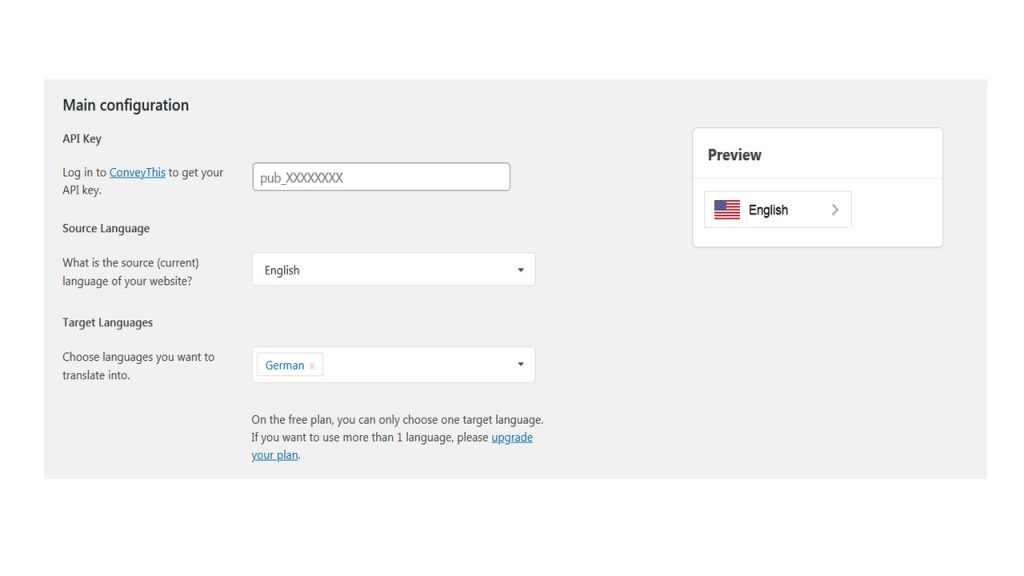
Can You Manually Edit Translated Content?
Yes is the answer. ConveyThis allows you the opportunity to edit, modify and make necessary adjustments to your translated contents and with that it will be easy to get your website optimized for user experience and search engine optimization (SEO).
For example, you may be targeting certain keywords in the translated text that will make your translated contents in that language optimized for Google search or perhaps, there is a specific phrase that should coined differently in languages like French, German, Vietnamese, or even Spanish in order to send the needed message, you can manually edit the translated contents to capture all of these. This is especially needed in the case of text widgets with contents that are manually uploaded.
It is possible to see welcome text in the text widget in the original language as shown below:
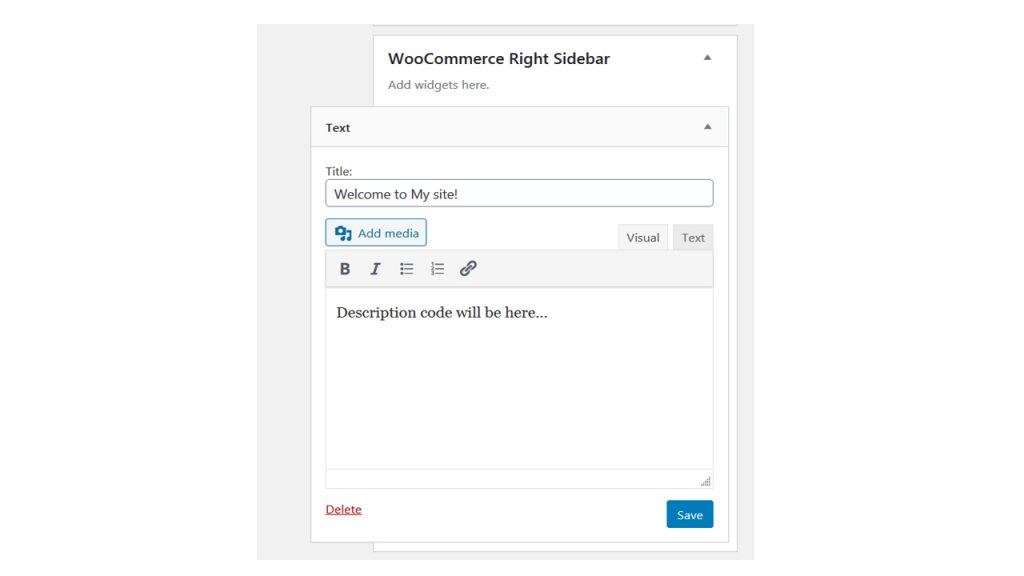
Think of whatever widgets. All that has been translated covers everything. Whether they are built-in widgets, installed widgets, uploaded widgets and/or widget that was added through plugins such as Jetpack and WooCommerce.
To help you get it a bit more clearer, try to open a page on your website through the use of the visual editor, you will notice that all widgets including the ones in the footer and sidebar are already translated. As if that is not enough, the page contents and navigation menus as well as every other items are translated.
Text that are already translated in your widgets can also undergo manual editing. How? Go to the visual editor and open it, then click on any of the widgets you want to translate. You will notice a pen like icon (i.e. editing icon) closer to it. Click on this icon and a window will pop up displaying both the original text and the translated text from the widget. With that and right there, you can manually edit the translated content to get the desired output. This is shown in the image below:
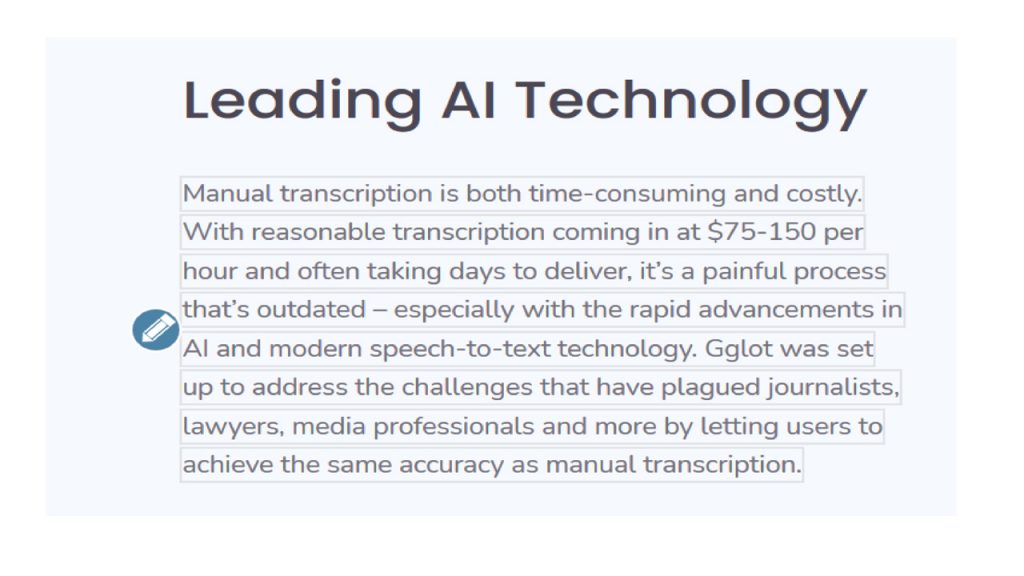
It is possible to use the translation service like ConveyThis to manually edit your translations. This is possible through your ConveyThis dashboard where you can set up your translation project to include native translators and professional translators.
Check over and over again all of the widgets that can be found on your website to see if they are translated correctly and nicely rendered in the other language. Should there be additional widgets sometimes later, it will be automatically translated. However, you may have to check through to ascertain if the translation is correct and if there is a need for modification you can edit it.
How to Add the ConveyThis Language Switcher to Your Widget Area
One of the great features of ConveyThis is the ability to add the language switcher button in the widget area of your website. This gives visitors the flexibility to change languages directly from the widget area, enhancing the user experience. To add the language switcher, go to the “Appearance” section in your WordPress admin panel, select “Widgets,” or use the customizer to access the widget editor.
From here, you can add the language switcher button, assign it to a specific widget area (such as the footer or sidebar), and save the changes. You can place the language switcher in multiple widget areas, ensuring that visitors can easily access it no matter where they are on the site.
Translating Widgets Is Key to a Fully Multilingual Website:
If you want to have an effective, efficient and professional multilingual website you must ensure that all elements of your website are translated. You don’t need to worry about or become overly anxious of how to handle this because this can be handled by using multilingual solution like ConveyThis. ConveyThis will take charge of your translation such that all parts of the website including the widgets, pages and posts are properly taken care of.
So far, in this article we have help you to see how you can translate the widgets that are available on your multilingual WordPress website. Also, we have considered how you can use widget as your language switcher in place of the common switcher button.
It is therefore best that you follow the above discussed guidelines so that you can translate your widgets and thereby you can boast of a complete multilingual website that is easy and not complicated for users or visitors of your website.
If your website is not well translated or it is partly translated, the visitors of your website can get confused with using your website and they can become discouraged such that they leave your website without achieving their goal of visiting in the first place.
If you try ConveyThis, you will find it easier to use and very simple. You may want to first use the free plan option to see how it works out with WordPress Plugin. And if you are thinking of other platforms such as Shopify and Squarespace, ConveyThis is always there to handle all for you. Start now and enjoy the countless benefits that come with translating your widget and owning a multilingual website.
Conclusion:
In conclusion, translating your website’s widgets is an essential and often overlooked step in making your site truly multilingual and accessible to a global audience. While content translation is crucial, ensuring that every interactive element, including widgets, is also translated can significantly elevate the user experience. Widgets are vital components that contribute to the usability and functionality of your website, from navigation menus and forms to call-to-action buttons and language selectors.
If these elements are not properly localized, you risk creating a disjointed experience where parts of your site feel foreign or inaccessible to non-native speakers.
By using tools like ConveyThis, you can easily manage translations across your entire website, including widgets, ensuring that all content is consistent and user-friendly in every language. ConveyThis makes the translation process seamless and efficient, offering both machine and human translation options to ensure the highest quality.
The ability to review and edit translations also allows you to fine-tune content for SEO purposes, making your website not only multilingual but also optimized for international search engine rankings.
Having a fully translated website—including widgets—ensures a consistent and professional appearance that fosters trust and engagement from visitors worldwide. This is crucial for businesses aiming to expand into international markets or cater to diverse audiences. By offering a seamless experience where users can easily interact with every part of your site, including the widgets, you are more likely to see increased user retention, higher conversion rates, and improved customer satisfaction.
Furthermore, a multilingual website can open doors to new business opportunities, as it allows you to connect with audiences who might otherwise feel disconnected due to language barriers. Whether you’re targeting specific regions, expanding your global reach, or improving your local SEO rankings, translating your widgets contributes to a complete and successful multilingual strategy.
Start today by integrating ConveyThis into your website to enjoy the benefits of a fully multilingual site. You’ll not only be able to cater to a wider audience but also create a user experience that’s intuitive, engaging, and inclusive.
The effort you put into translating your website’s widgets and content today will pay off in the long run with increased reach, stronger brand recognition, and expanded opportunities in global markets.
Additional Resources:
- ConveyThis Integrations – To explore compatibility with WordPress.
- How to Translate WordPress – For more guidance.
- Help Guide for Translating WordPress Websites – For step-by-step support.
- ConveyThis Widget For WordPress – To explore the way to going global on WordPress.
Translation, far more than just knowing languages, is a complex process.
By following our tips and using ConveyThis , your translated pages will resonate with your audience, feeling native to the target language.
While it demands effort, the result is rewarding. If you’re translating a website, ConveyThis can save you hours with automated machine translation.
Try ConveyThis free for 7 days!
